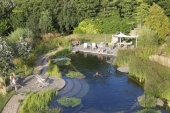I'm not convinced. Sorry to be Mrs. Doubt, but the hotwater out of the system is always higher than the coldwater inlet. So, there is rising.
I've been trying to find the logic of how these things work online, but i just can't figure out the mechanics. I want to play with this...though I am always short on free time

.
Here's the plan I was thinking for a pump...
Top of fountain with hose plugged into it under water.
--> water overflows and falls to larger, deeper tank.
-->hose at the bottom of the tank is filled to the deeper tank's water depth based on the water pressure. The rest is filled from syphoning
--> The hose goes to a section set-up for solar heating. The water heats & expands.
---> The hotwater expands and wants to go somewhere. It can't go down because 1) heat rises, 2) there's water pressure pushing up.
---> heated water pops out of the top of the fountain. (go to top)
At the same time, the water falling out of the top of the fountain into the large tank causes the water pressure in the hose to rise, also propeling the movement.
As long as your not trying to lift the water real high, and you make sure that the heating element always has water in it, what's the problem?
As for bubbles in the system ruining it, sometimes bubbles get in people's water pipes, and syphons are used in irrigation where the water probably has a fair amount of oxygen in it. A big bubble can cause problems, but a some isn't so bad.
The one issue would probably be if the heat went away and the system lost pressure, you'll probably end up having to re-start it by re-filling the system with warm water...
I have been known to make things that don't work, but I dunno...I'm trying to mimick natural water circulation with a little push.
What do you think?

























 The idea was to get away from an electric pump. However pushing heated water to the bottom of the pond is a cool concept. If you can figure that out I could probably keep talapia aluve tn a backyard pond in central Oklahoma. That would be very cool!
The idea was to get away from an electric pump. However pushing heated water to the bottom of the pond is a cool concept. If you can figure that out I could probably keep talapia aluve tn a backyard pond in central Oklahoma. That would be very cool!



 .
.
















